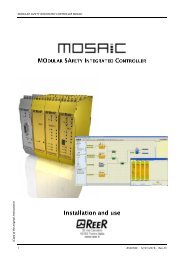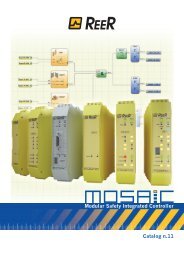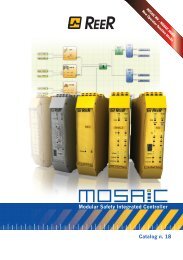BB ELECTRONICS CATALOG (2010)
Catalog from B&B Electronis (2010)
Catalog from B&B Electronis (2010)
Create successful ePaper yourself
Turn your PDF publications into a flip-book with our unique Google optimized e-Paper software.
Backup Network<br />
Mobile Police Safety<br />
Wireless<br />
Cellular Technology – The Alphabet Soup Explained<br />
Nothing makes selecting a product more difficult than navigating through datasheets filled with acronyms. Unlike most<br />
technophiles, I absolutely hate acronyms. All technologies have their fair share of random letters grouped together that mean<br />
something to somebody. But it appears that the engineers in charge of cellular technology got in line twice when the letters were<br />
being handed out. And they don’t even sound cool… at least you can pronounce ASCII…<br />
The most confusion comes when discussing the type of cellular network. When you ask<br />
somebody this question, they will usually answer with the company they send the bill to.<br />
But, the answer is actually GSM or CDMA.<br />
GSM stands for Global System for Mobile Communications. It is the most<br />
popular standard for cell phone networks in the world. This is the standard that<br />
AT&T uses in the U.S. It is also very popular with most international carriers.<br />
Besides the technical difference that I will not go into, GSM networks require a<br />
SIM card. SIM stands for Subscriber Identity Module. As the name implies, this<br />
card identifies your device on the network.<br />
CDMA is short for Code Division Multiple Access. This system is mainly used<br />
in the U.S. CDMA systems do not use a SIM card. Instead, your device needs to be<br />
programmed. The CDMA network is used by Sprint and Verizon in the U.S.<br />
Now for the G’s… GSM and CDMA are both 2G networks. The “G” stands for<br />
Generation. The first generation was called AMPS. It was an analog network used way<br />
back in the 80’s. Second generation GSM and CDMA networks are digital and can handle<br />
voice and data - data being what we care about. 2G networks are relatively slow. Third<br />
Generation, or 3G networks are faster and can deliver data at speeds comparable to your home<br />
DSL router or better.<br />
Serial Radio<br />
Modems Modular I/O Antennas WiFi/802.11<br />
Ethernet<br />
Bridges<br />
Cellular<br />
Routers<br />
There are several types of 3G networks.<br />
EV-DO: This stands for Evolution-Data Optimized. It is associated with CDMA networks and can deliver data at speeds<br />
ranging from 144 Kbps to 2 Mbps.<br />
UMTS and HSDPA: UMTS stands for Universal Mobile Telecommunications System. HSDPA stands for High-Speed Downlink<br />
Packet Access. These are upgrades to GSM networks, and like EV-DO, they provide high speed data throughput. Without<br />
getting technical, the only difference between the two is that HSDPA is faster than UMTS and is sometimes called 3.5G. In the<br />
U.S., AT&T offers both UMTS and HSDPA.<br />
In between 3G and 2G are the “2.5G” networks. These are generally good enough for most industrial and<br />
commercial applications. A variation of the CDMA standard is 1xRTT, or “1 times Radio Transmission<br />
Technology.” It delivers speeds between 30 Kbps and 90 Kbps. On the GSM side are GPRS and EDGE.<br />
GPRS stands for General Packet Radio Service. EDGE is short for Enhanced Data Rates for GSM Evolution.<br />
They also deliver between 30 and 90 Kbps data rates.<br />
www.bb-elec.com<br />
815.433.5100<br />
Low-profile,<br />
multi-band<br />
antenna<br />
page 97<br />
93






![BRESIMAR(asaTek)-Beckhoff-Livro Formação Técnica TwinCAT 2-v1.2_2009 [pt]](https://img.yumpu.com/62853104/1/190x245/bresimarasatek-beckhoff-livro-formacao-tecnica-twincat-2-v12-2009-pt.jpg?quality=85)





